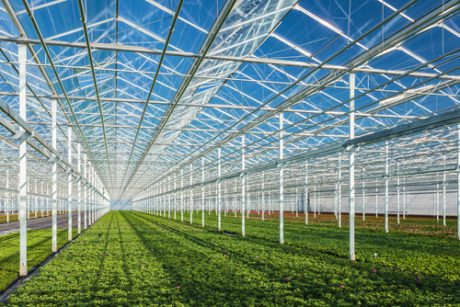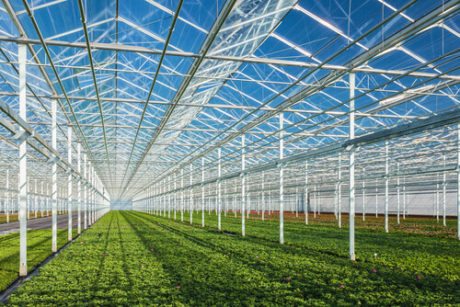 A greenhouse is also called a glasshouse or a hothouse. It is a structure where plants – fruits, vegetables, flowers – are grown. It attracts heat because the sun’s electromagnetic radiation warms the plants, soil, and other components within the greenhouse. Air is warmed from the hot interior area inside the structure through the roof and wall.
A greenhouse is also called a glasshouse or a hothouse. It is a structure where plants – fruits, vegetables, flowers – are grown. It attracts heat because the sun’s electromagnetic radiation warms the plants, soil, and other components within the greenhouse. Air is warmed from the hot interior area inside the structure through the roof and wall.
How does a greenhouse capture heat?
A greenhouse uses a special kind of glass that acts as a medium which selectively transmits spectral frequencies. Spectral comes from the word “spectrum”.
In layman’s terms, a spectral frequency can be defined in terms of the following principle: any object in the universe emits, radiates or transmits light. The distribution of this light along an electromagnetic spectrum is determined by the object’s composition.
Therefore, the glass of a greenhouse traps energy within the greenhouse and the heat in turn provides heat for the plants and the ground inside the greenhouse. It warms the air near the ground, preventing it from rising and leaving the confines of the structure.
For example, if you open a small window near the roof of a greenhouse, the temperature drops significantly. This is because of the autovent automatic cooling system. An autovent is simply a device used by greenhouses that maintains a range of temperatures inside. This is how greenhouses trap electromagnetic radiation and prevents convection (transference of heat by currents within a fluid).
Curious about how the idea of a greenhouse came about? It goes back to the days of the Romans, who – as history annals show – were the first people to create a structure to protect plants. Using heated pits, they put up slabs of rock to form primitive greenhouses. The term “glasshouse” which is the correct name of this structure, was adopted sometime in the 17th and 18th centuries.
At that time, however, the error was in believing that heat was more important than light for plants to thrive. Structures were being built to exclude the entry of light, but by the time the glass tax of 1845 was abolished, the design of greenhouses started to change.
Builders realized then that a curved roof instead of a flat one allowed higher concentrations of the sun’s rays, and that by using iron instead of wood, the greenhouse could be structurally reinforced and made capable of absorbing more light.
A man named Joseph Paxton, a horticulturist, appeared on the scene and introduced changes to the greenhouse design concept. He was famous for the Palmhouse at Kew Gardens which he built in 1842. It measured 110 meters long, 30 meters wide and over 20 meters high. Nine years later, he built the Crystal Palace.
It has been forty years now since major improvements in materials and design have been integrated into the greenhouse, and it is now very much a feature of any home garden.
One greenhouse principle is the ability to extend the growing season. Early vegetables can be planted indoors and then transplanted when they mature. A greenhouse owner also gains several weeks to the growing and sowing period especially if there is a form of heating installed.
Controlling temperature, light and moisture is one of the things that greenhouse owners can do; this way they obtain the guaranteed results they want. Our science classes taught us that many plant varieties enjoy a warm, moist temperature.
In addition to extending the growing season and being able to control temperature and moisture inside a greenhouse, a gardener learns to hone his gardening skills by getting acquainted with as many varieties as he can in the greenhouse.
He may choose to specialize on one species of fruit or vegetable or flowering plant. Many have built greenhouses for the purpose of growing and preserving their orchids.
Whatever the intent is, a greenhouse will deliver hours of emotional satisfaction to owners. Imagine being able to grow juicy tomatoes or producing new kinds of plants by the simple act of propagation.
Don’t be discouraged by the fact that you have limited space in your garden or that is completely paved or concreted. You can still make use of limited space.
If space is a problem, there are what people call “free standing” greenhouses that take just a few square feet of space, and some can be installed on balconies or roof tops.
 Today, you can choose any greenhouse frame you want, including color. If you’re not into aluminum, you can build one with a dark frame color or go for earth colors instead.
Today, you can choose any greenhouse frame you want, including color. If you’re not into aluminum, you can build one with a dark frame color or go for earth colors instead.
Let’s mention a few of the numerous benefits of greenhouses:
- Control of growing conditions for plants to obtain desired results,
- Protection from the elements and from birds and animals,
- Facility in controlling pests and diseases,
- Easy access by the elderly and disabled, given that greenhouses are less physically demanding than wide open crop spaces and fields,
- Possibility of reducing gardening costs because the owner or gardener grows his own plants,
- Possibility of widening the variety of plants for general gardening purposes.
- A greenhouse serves as an escape or refuge after a trying day.





-
Add a note